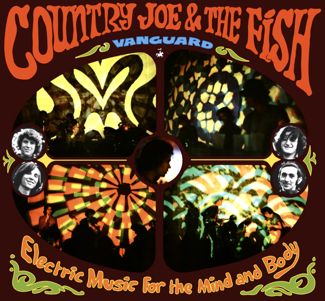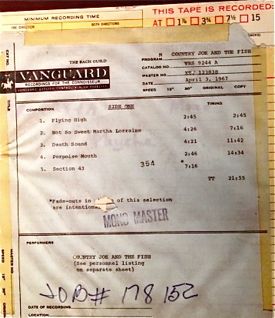“Electric Music for the Mind and Body” opens with the tale of a hippie hitchhiker, forlorn, ignored and waterlogged by the side of an L.A. freeway.
The hours slog by. Finally, the hitchhiker is picked up by a couple of “cats in a Cadillac” — one wearing a fez — who give the traveler enough money for airfare. He goes “flying high,” all the way home.
It’s a workable metaphor for the fortunes of the first County Joe and the Fish album, one of the stone-cold classics of the psychedelic music era.
Owing perhaps to the condition of the master tapes, “Electric Music for the Mind and Body” languished in the compact disc era. The band’s label, Vanguard Records, released a CD in 1990 that bordered on the shrill, with a mix out of whack with the original stereo. And so fans waited more than two decades for the real deal, for a deluxe rerelease similar to those given the Jefferson Airplane and Doors classics.
Hang on to your fez, folks: “Electric Music for the Mind and Body” is flying high once again.
British rerelease specialist Ace Records has put together a stunning two-disc set that includes both the stereo and mono mixes of the album. A 40-page booklet gives the album its due, with pull-no-punches comments from the band and producer Sam Charters.
The CD is available as an import in the U.S., going for $23 or so (£12.14).
The sonics are a reminder of how good a CD can be. The stereo disc brings out the album’s warmth, isolates moments of virtuoso playing, and playfully fucks with your head, as a drug record should. The stereo mix is the original one sweated over by Charters, unheard since it was replaced by Vanguard in the 1980s. Meaning the ’60s mix hasn’t appeared on CD, until now. Ace Records explains:
In the decade after the album was first released, the 2-track master suffered irreparable tape damage and oxide loss. In the early 1980s, a decision was made by Vanguard to remix the record, and that is how it has appeared in subsequent repackages.
The CD booklet addresses the differences: “While the balance was very close, there are distinct differences on certain tracks in the echo, equalization and timing between the original and the remix.”
The mono mix, with “similarly notable disparities,” hasn’t been heard since the late 1960s release on vinyl.
The booklet covers the album’s strengths and weaknesses. Producer Charters notes the “amateurish” qualities that are “part of its charm.” Lead guitarist Barry Melton says the sound he was after “was probably fairly trite,” but “it’s my inability to execute what I was after that makes it sound unique.” As for the silvery screech of the electronic organ, bassist Bruce Barthol recalls, “We hated that Farfisa.” The band hated the album cover as well.
Yet “Electric Music for the Mind and Body” remains quite possibly the best psychedelic rock album ever made.
It could have been called “Drug Music for the Mind and Body.” Acid seeps through every note, thanks in part to the band’s habit of tripping while rehearsing and performing. “We were probably one of the few well-known bands that repeatedly took psychedelics together,” singer Joe McDonald says.
“If you want to understand psychedelic music, and you haven’t heard “Electric Music for the Mind and Body,” then you probably don’t know what you’re talking about,” McDonald says flatly. Try to find a music critic who would disagree.
Released in April 1967, “Electric Music” could hold the distinction of first psychedelic rock album. Some will point to the 13th Floor Elevators’ debut album, others to the Byrds’ “Fifth Dimension,” and others to the Yardbirds’ “Roger the Engineer” — all seminal in their own ways, but all intermittently psychedelic. And “Surrealistic Pillow,” which came out the same month.
“Whoever might claim the first psychedelic record,” liner notes writer Alec Palao says, “all must agree that ‘Electric Music for the Mind and Body’ is as good as it gets.”
Consumer note: Ace Records is making good on an error that may or may not appear on disc 1, the mono version. “Death Sound” ends prematurely on some copies. (This doesn’t affect the stereo disc.) Contact the label via its web site for a replacement.


I had an 80’s rerelease of the album on Vanguard that I thought sounded clear as a bell and great. But I’d definitely like to have this. I thought the farfisa was part of the “electric music” charm of the album. Kind of spooky. And the cover is great.
Along with the Pretty Things’ song “L.S.D.”, Electric Music For The Mind And Body has to be one of the first albums to feature a direct reference to the drug in the song “Bass Strings”.